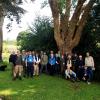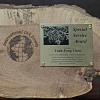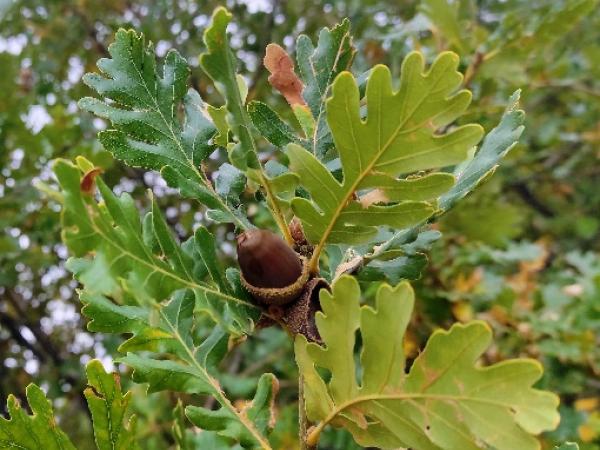Editor's Picks
Plant Focus
A new species of oak gall wasp has been described in Mexico, and it has been named in honor of our very own Allen Coombes, former President of the IOS (2006–2009), first Vice-President (1994–2000; 2003–2006), and co-Editor of International Oaks since 2012. Andricus coombesi is a cynipid gall wasp that induces galls on the acorns of the Mexican oak Quercus grahamii. The wasp has several characteristics that make it unusual. To better understand its significance, here is an overview of what is known about this fascinating group of insects.

Certain insects have the ability to cause plants to form tumor-like, nutrient-rich growths called “galls”. In doing so they perform a fascinating example of parasitic symbiosis, an intimate, long-term interaction between two different species where the parasite benefits and the host plant is harmed in some way. The ability has evolved independently in six insect orders, one of which is Hymenoptera (bees, wasps, and ants), and a large number of vascular plant species are susceptible to galling insects, including genera important to agriculture, such as Vitis (grape), Triticum (wheat), Orzya (rice), and Vaccinium (blueberry). In these cases they can cause substantial drops in crop yields.

Within the Hymenoptera, gall wasps are found in a group called the Cynipoidea, a lineage dominated by parasitoids that attack insect larvae. It is thought that gall induction on plants evolved from a common ancestor that parasitized other insects. About 70% of cynipids are oak gall wasps, i.e., they attack trees in genus Quercus. Each species of gall wasps typically attacks a single species of oak or closely related group of species, inducing a distinct gall on a single type of plant tissue, e.g., roots, stems, buds, leaves, petioles, fruit, or flowers. The galls can contain one or several chambers, each housing one or many developing wasps.
A gall is created when the wasp co-opts molecular control of the oak’s tissue to create a novel organ for its own purposes. The initiation, development, and maintenance of the galls are controlled by the wasp, but the gall itself is all plant tissue. Little is known about how galls are induced, but the most common theory involves plant hormones such as auxin. Galls are initiated when the wasp inserts one or more eggs, together with a maternal secretion from the venom gland, into the oak’s meristematic tissue, which contains cells that can develop into different plant parts. The cells next to the egg promptly die, while the remaining tissue differentiates into a type of wound callus. Rapid cell growth then takes place: nutritive cells form the gall’s inner larval chamber, and then a secondary layer of tissue differentiates into the species-specific structure of the gall’s outer cortex. It has been shown that the wasps significantly modify the expression of almost a third of the oak genome: they not only alter the oak’s tissue but create a novel organ on the host plant. It is also thought that the larvae continue to manage the gall’s growth through their active chewing and salivary gland secretions.

By creating galls, wasps receive nutrition from the oak and secure protection against environmental conditions and numerous predators. Morphologically the galls are very diverse, and each of these factors is thought to have played a role in the evolution of this variation. Some of their traits are known to significantly reduce mortality from natural enemies, something the wasps desperately need, as their enemies are legion and can inflict high mortality (up to 99% in some cases).
Cynipid gall wasps have complex reproductive processes. They reproduce via what is termed cyclical parthenogenesis, involving two annual generations, alternating sexual and asexual reproduction. If the term parthenogenesis reminds you of an ancient temple in Athens, you are on the right track: parthenogenesis, which refers to asexual reproduction, derives from Ancient Greek παρθένος (parthénos, “virgin”) and γένεσις (génesis, “origin, creation, generation”); the Parthenon in Athens derived its name from the name of the goddess Athena Parthenos (Athena the Virgin). While other organisms are cyclically parthenogenic, most of them primarily reproduce asexually and occasionally sexually, induced by changes in environmental conditions. In gall wasps, the alternation is mandatory: the sexual generation mates and produces the asexual generation, then this second generation produces males or females parthenogenetically. Within the same wasp species, each generation creates different kinds of galls, depending on the different enemies and challenges they face.

Gall wasp systems are thus a source of undiscovered diversity. They exhibit a global distribution, being found on every continent save Antarctica, and estimates of the number of species are still imprecise. This is due in part to the fact that many of the regions that are predicted to be the most biodiverse are not yet explored. Regions with a high potential for host diversity are likely to have a high diversity of gall wasp species. Two regions are especially notable: Mexico and Central America, one of the global diversity hot spots for Quercus, and the oak forests of Southeast Asia, Japan, and China, which have not so far been intensively sampled.

The newly described species of oak gall wasp was first observed by Allen Coombes in June 2022, on several Q. grahamii specimens at the Botanic Garden of Puebla University, where Allen is currently Curator of Scientific Collections. Allen in fact observed the old galls, from which the adult wasps had already emerged. The following January, Betzabeth Pérez-Torres collected new galls and was able to rear asexual adult gall wasps, which were studied, described, and deposited in several institutions as type specimens for the new species. So only the asexual generation is known. The sexual generation may be observed at a later stage. This is the case with many gall wasp species, which are known only from the generation that reproduces through parthenogenesis. It seems likely that the unknown sexual generation develops quickly: the asexual adults emerge in January and the following (sexual) generation would have to deposit their eggs shortly afterward, because the galls start to form in the first stages of acorn development.
What is unusual about Andricus coombesi is that it attacks the acorns and destroys them, causing them to practically disappear. This is the first gall wasp found on Q. grahamii, which for a long time was considered to be a synonym of Q. acutifolia; in 2015 Q. grahamii was formally recognized as a distinct species, and the name Q. acutifolia was transferred to what had been known as Q. conspersa, a similar species. While a few other gall wasps had been described on Q. acutifolia (previously Q. conspersa), none of them attack acorns. Only two other Mexican species of wasps are known to produce galls on or in acorns, but they do not cause the acorn to disappear as this new species does.

The paper that describes the species includes a detailed technical description of the insect and fascinating photos taken by Juli Pujade-Villar using a scanning electron microscope. The images look like some of the aliens we are used to seeing in science-fiction movies about extraterrestrial invasions (it should be noted that the wasp was named after Allen in recognition of his having found the galls of the species, not due to any physical resemblance!). The galls themselves, also illustrated in the paper, are equally monstrous, and in their case an appropriate cinematographic reference might be David Lynch’s The Elephant Man (e.g., the image below).

The galls produced by A. coombesi resemble those of other species in the genus that produce woody tuberous galls, but they differ in that they are not strongly lignified. They are multilocular, meaning they contain several chambers that house the larvae; they are located on female flowers and completely deform the acorn. The galls are light yellowish with a velvety surface when young and turn brown and smooth when mature. The wasp is distinguished from other Andricus species due to certain differences detailed in the paper.

So far A. coombesi has only been found on Q. grahamii and in the state of Puebla, but it is expected that it will be found in the other Mexican states where the oak grows, and probably on other oaks. The fact that the gall destroys the acorn makes A. coombesi potentially harmful, affecting the regeneration of Q. grahamii. In Mexico all previously described harmful or potentially harmful species attack branches; this new species is the first potentially harmful species for acorns. Though certain aspects of the discovery suggest a horror story, we should remember that these are important steps in discovering the mostly unknown biodiversity of this fascinating family of insects and their relationship to our favorite genus of trees.
Further reading
Much of the description of cynipid gall wasps above is taken from:
Egan, S.P., G.R. Hood, E.O. Martinson, and J.R. Ott. 2018. Cynipid gall wasps. Current Biology 28(24): R1370–R1374. doi: 10.1016/j.cub.2018.10.028
The description of Andricus coombesi Pujade-Villar & Pérez-Torres n. sp. can be found here:
Pujade-Villar, J., B.C. Pérez-Torres, A.J. Coombes, A. Aragón-García, M. Rodríguez-Acosta, J.F. López-Olguin, and G. Melika. 2024. Description of the first species of gall wasp (Hym., Cynipidae: Cynipini) on Quercus grahamii (Fagaceae). Zootaxa 5403 (3): 309–376. doi.org/10.11646/zootaxa.5403.3.6
The nomenclature of Q. grahamii, Q. conspersa, and Q. acutifolia was resolved here:
Valencia-A., S., G. Flores-Franco, and J. Jiménez-Ramírez. 2015. A nomenclatural revision of Quercus acutifolia, Q. conspersa and Q. grahamii (Lobatae, Fagaceae). Phytotaxa 218 (3): 289–294. https://doi.org/10.11646/phytotaxa.218.3.7















